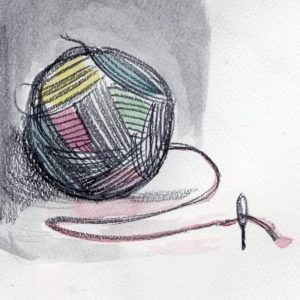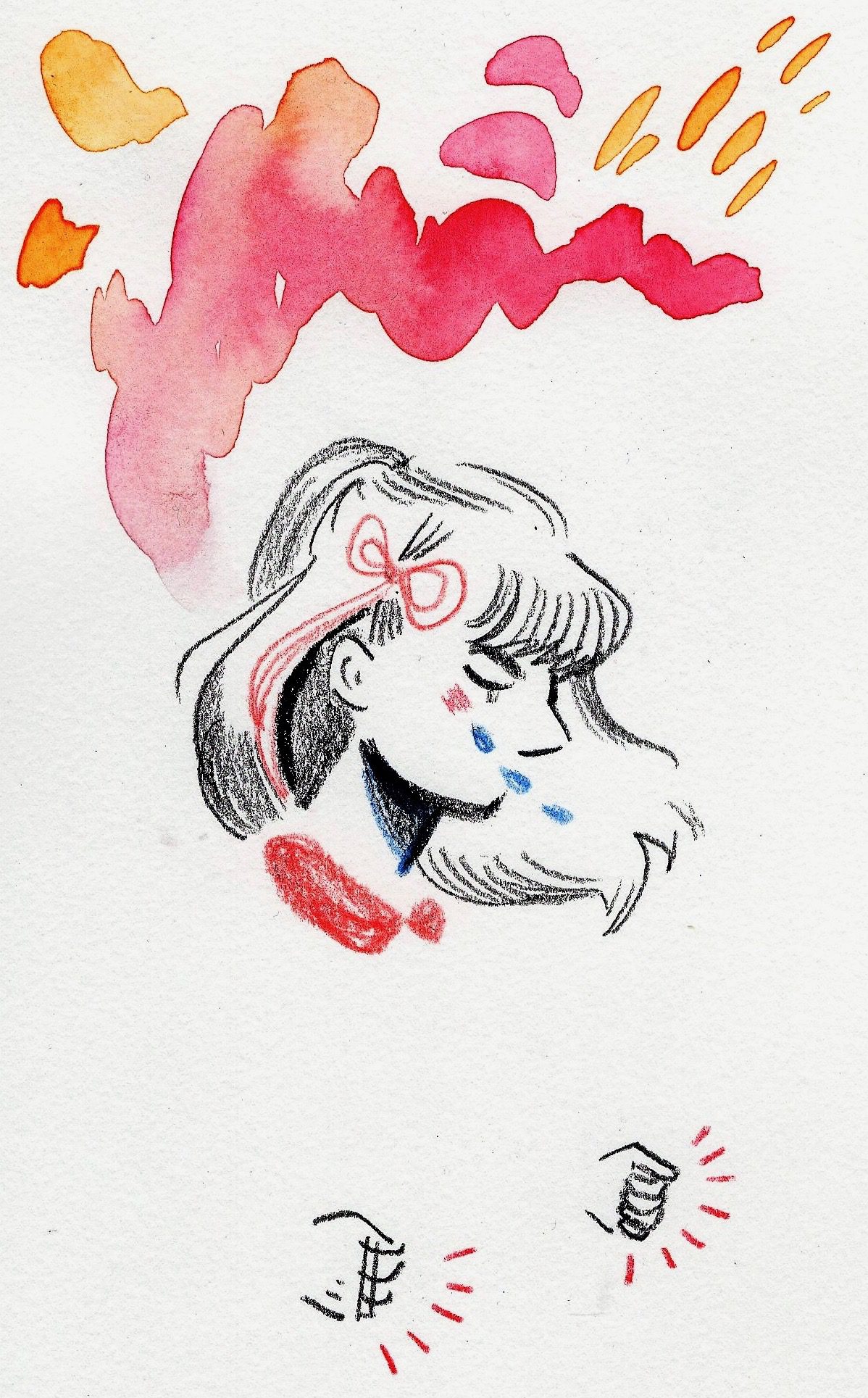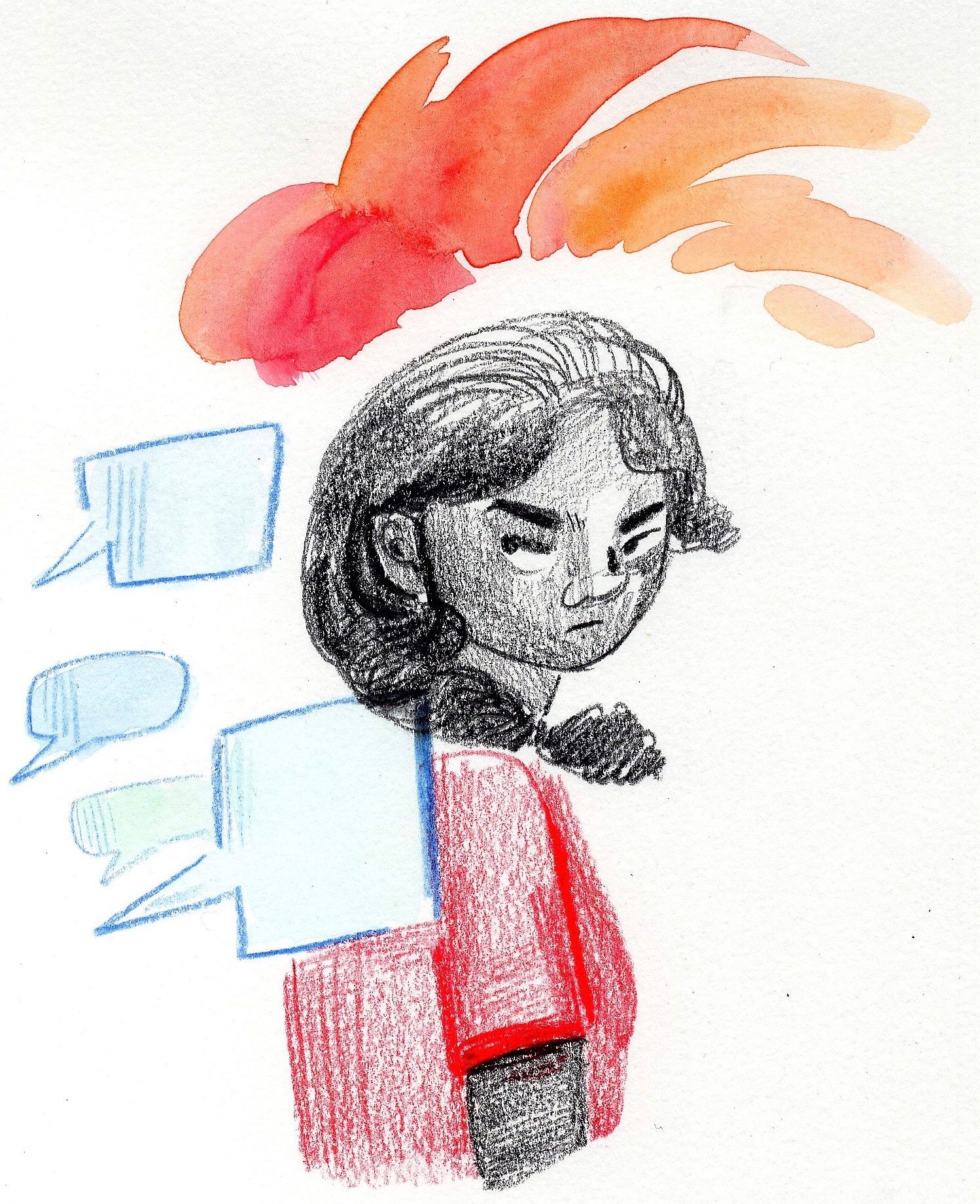
“We are volcanoes…” Ursula K. Le Guin said in her graduation remarks at Bryn Mawr in 1985. “That’s what I want—to hear you erupting.”
Women are angry. At least, that is what we’re hearing. It’s the year of the angry woman, the pussy-hatted, sign-carrying, voice-raising woman. Are we becoming Le Guin’s volcanoes?
I had a rage body, once, but I can’t remember the topography of her. But as the mother of a three-year-old, I know that I, too, must have raged. Purple-faced screaming. Irrational demands.
When my daughter is angry, she slams the door to her bedroom and yells through it for me to “take some space.” She tells me we’re “not best friends anymore.” That she doesn’t like me. I tell her that it’s okay. Her big anger is okay.
My large emotions as a child were often not okay. I was called a drama queen. I was told to turn off the tears. My parents nicknamed me Sarah Heartburn, and would clap for my “performances” of rage.
I tell my daughter her largeness is okay. And I tell myself. I think she’s the only one who believes me.
Is this the year I finally erupt?
The father of three abused daughters asks the judge for five minutes, then one minute, alone with Larry Nassar. His requests are denied. Nassar “treated” all three of this man’s daughters—treated, with his ungloved fingers in their bodies, following no medical protocol.
I don’t know if they told or didn’t, this particular man’s three particular daughters. If they told, I imagine they were reassured by someone, told this violence was a form of care.
Where could they could point and say, here is where it hurts? It’s not like he was bruising them visibly.
Is it violence if it doesn’t leave a mark?
The dad in the courtroom, with three daughters, jumped the barrier and went for Nassar himself. He was pinned by the marshalls, sent to jail for contempt, then dismissed because this violence was understandable.
Fathers of abused daughters have an understandable level of violence. My own father said he wanted to kill my teacher, the one he knew about. He made jokes about shotguns on my thirteenth birthday, but they were all for show. Or so I thought. I had never seen my father violent, though I had seen him angry.
When fathers express rage and threaten violence toward those who harm us, we understand that this is a reflection of their love. Protect the women and children. I feel grateful to my father, even as I wonder why I feel it.
Do daughters get an understandable level of violence, and if they do, what does it look like?
In a different courtroom, a judge reads Nassar’s second sentence. One hundred seventy-five years. This is retribution for the hundreds of young bodies hurt over decades.
Nassar was already serving a sixty-year sentence for child pornography, some of which he created himself. He plead to these charges instead of going to trial because he didn’t want to face the victims’ testimony. He tried to silence them, keep them from telling their stories, again.
Judge Aquilina allowed over one hundred and fifty women to read their victim impact statements.
Nassar asked to be excused. He begged the judge not to make him sit through these weeks of victim testimony, for the sake of his mental health. He couldn’t stand to hear about the impact of what he’d done.
His request was denied.
“I have signed your death warrant,” Judge Aquilina announced on the last day, because her sentence guaranteed he will die in prison.
Watching this was vindication: a powerful woman, expressing my disgust. But for others it was too severe. Why? The judge didn’t punch the doctor. The judge didn’t jump the barrier, ask for time alone with him, or do anything beyond convey her utter disgust at a convicted child pornographer and assaulter. Why were her feelings so unseemly as to launch a thousand op-eds?
When I was ten, I started to grow breasts. Or at least, that’s what my books said these weird puffy fleshbits on my previously unremarkable chest were. Breast buds. The phrase a pit of dread in my stomach.
On a family vacation in Hawaii, my mom and I were driving. She mentioned that some of my clothes were no longer appropriate. I cried and stared out the window. She blamed the hormones in the non-organic chicken I’d eaten. A few weeks later, a well-meaning auntie sent me a pink Jockey training bra for my birthday, and my humiliation grew. Now I had to wear a bra. Now I had to use a pad. Now I was blossoming.
Game over.
As my body changed—ahem, blossomed—my personality did, too. Toddler-sized tantrums were expected from children, but now I was on the verge of becoming something else. I needed to control myself. I needed to become smaller. The women around me compressed themselves, and I tried to do the same. Smaller in body, smaller in feelings. More contained. A nice container, like an ornate vase.
I remember my mother explaining once that her father hated women crying. He thought it was manipulative, and nothing made him more angry. I extrapolated his preference out to all men. My tears were not about me; they were another reaction that adults perceived as scripted, played for effect.
I noted men reacting to my emotions. I learned to tone it down.
Soft, then softer.
I taught myself to implode.
On that trip to Hawaii, we visited Kilauea, the active volcano on Hawaii’s big island. It has been erupting since 1983, the year my brother was born. We stayed at a hotel near Volcanoes National Park.
I remember the fog and the surprising cold. We were high up on a mountain, and I was still tanned and salty from the sea. I ached to go back to the beach, lie still in the sun, and be warm. Instead, we spent the night near Kilauea, and went hiking the next day.
The pressure building in a pool of molten rock pushes volcanoes open. Once the lava erupts, the fast flowing parts dry into sharp-edged rocks, treacherous to walk on. Even long after eruption, a volcano can hurt you.
Eventually, with time, weather, wind, water, the rock erodes into sand, the black sand beaches where my mother and I walked.
We hiked through Nahuku, a lava cave over five hundred years old. Pitch black, except for the tiny lights the park installed inside. I walked where once a giant lava river ran, and ran my hands over the rippling cold rock walls. We hiked through dense rainforest to Akaka Falls. I remember the thick air on the canopied trail, then breaking through, high on a bluff to see the white water streaming across the vista. The Falls was majestic from that distance, picturesque, though up close it roared with a nightmarish sound.
Eruptions have been known to knock down entire forests, trigger tsunamis, flash floods, earthquakes, mudflows and rockfalls. Magma can build mountains, or flatten whole towns.
It’s also the beginning of life. The most fertile land is at the base of volcanoes. The rivers and the waterfalls and the lush green around Hawaii, and the beaches and the sea turtles and all of the orchids? None of it would be there without the volcano.
In middle school, on the school bus, every afternoon, my torturer, Derek, yelled loudly, “Are those oranges or grapefruits in your shirt?”
I pretended not to hear him, but everyone heard him. The boys on the bus slapped him high fives, and the girls laughed. It wasn’t even a joke. It was predictable. Every day, same punchline. Sometimes he used a different fruit.
When I told adults about Derek, they told me he probably liked me. This was flirting, they said. This was a compliment.
I was twelve. By the age of ten, most girls have internalized the messaging around rage and violence. This thing is unladylike. This thing is ugly. This thing is not for you. I remember shaking, not with rage, but with tears. Violence became something more feminine, more wet.
Rage tears are a real thing; most of the adult women I know have them. We don’t get angry, we get sad.
That body I didn’t ask for, and couldn’t control. It was a wild thing, free from all the rules I knew, but subject to different obligations. For one thing: the body made rage, even if the head said it was something else. The body shook and the head labeled the shaking sadness.
The body liked, likes, things that I didn’t. I was the head, cut off from my body. I float, a mind on top of a moving transformer. Separated. The body has its own ideas. Maybe it was a ghost body, trailing my snappy brain who calculated and over-thought, analyzing each interaction to be sure. Maybe it was a zombie body, dragged behind, halting, hungry for flesh.
Sometimes the head and the body agreed, but not always. When it was a fight, it was a toss-up who would win. When it came to boys, the body won, mostly. Certain violences made the body as limp and wet as a peony. The head screamed no no no but the body melted yes.
It was probably confusing for people who had never known that split. But it was just normal to me. One part eager, nodding, open mouth and grasping hands. The head should take a nap, or go to the ceiling and observe. From there, she could see everything, but she took bad notes.
The body took notes in language the head does not know. Secrets got lost in muscle tissue, a spasm here, the smell of a pine cone, whoosh of fall wind, golden slant of light, vanilla on my tongue. The body quickens, grasps, arches, and slicks. The body knows what the head does not remember, didn’t see, conveniently didn’t notice at the time. The head is smart. The body is reckless.
I was told that violence was love, told that love was fear, told that rage was unladylike and anger was drama. I was told that I should acquiesce, say yes when asked nicely. Told that it was my job to make other people feel comfortable. I had to fix it all, carry it all, handle it all, take it all. I was not allowed to give it. And I was not allowed to retaliate if it hurt, especially if the mark was invisible.
What if I had punched Derek in the face on the school bus? Would anyone understand my violence? What if I had dropped my small, cold, seventh grade fist into his stinking hot belly? Would it have changed anything?
I love his violence, but I lost my own.
Or.
I love his violence because I lost my own.
Is there a relationship between the violence that came through me, and the violence that came at me?
Women have always had rage, but we’ve sublimated, and presented it differently. We direct rage toward ourselves: too fat, too loud, too cellulite-ridden, too wrinkly, too fake, too plastic-looking, too tall, too short. We direct rage toward other women: she shouldn’t wear that, who does she think she is, why her, why not me. We are endlessly sad. We have complicated eating disorders. We swallow our rage like good women, cut our arms, take too many pills. It’s easier, it’s more comfortable for you when I take my rage and swallow it with a glass of water.
Have we finally had what Adrienne Rich called in 1974 “enough suicidal women poets, enough suicidal women, enough of self destructiveness as the sole form of violence permitted to women?”
Have women had their fill of destroying themselves? Have I? Am I ready to wear the explosive mantle? I have seen what happens to the women that wear their rage too brightly: they become “crazy.”
And I’m afraid of the way I burn behind the ears, in the belly. I am uncomfortable being relentlessly destructive.
What if we break dishes? What if we break noses? Will our children still cling to us if we’re erupting instead of softly imploding? What will we gain, and what will we give up in the pursuit of wholeness?
For my part, I have one girl to raise. What I wish for her is that rage be an energy, and that sadness have its place. May she navigate her emotional landscape with more confidence. She has the map. May I be her flashlight when she needs one.
Are we there yet? Are we willing to go?
In my dream I hiked a riverbed, predictable for miles, then turning, cutting forest away, its steep mudbanks topped with thick grasses. To the rhythm of my footfall, I repeat: I am not your yes.
Without warning, the water drops from clear ripples to bright white.
I am tired of being a good girl.
Water has to move, even as rocks give way to air. I know this waterfall, but it’s new to my dream-self. My body beckons the bright white rage of her roar. I am not the yes you made of me. I am not the yes you took.
I am not your yes.
Where everything tumbles onto the rocks and over, I am stepping into roaring, where it all drops away. The new shape is thunder. This is not the water of your placid imagination. This is the fury water.
This is what happens when you let her down.
When I was a child, white noise was the soundtrack of my nightmares. It terrified me. But this dream is all white noise.
I drank from the waterfall.
I did not die.
***
Rumpus original logo and art by Aubrey Nolan.
***
The Thread is a monthly literary conversation, developed for The Rumpus and edited by Julie Greicius. Send us what you’re reading that you can’t stop thinking or talking about to mkorbel@therumpus.net, or reach out to Marissa on Twitter or Facebook, and she just might pull the threads of it apart for you in a future column.







